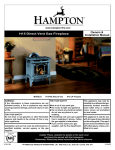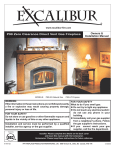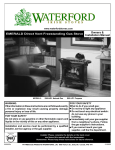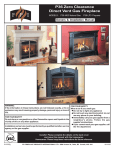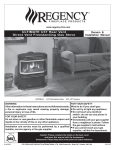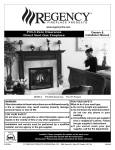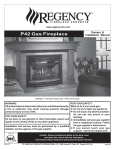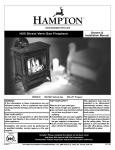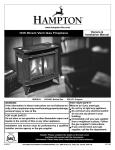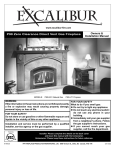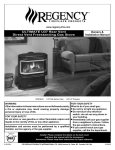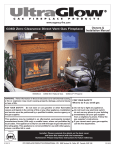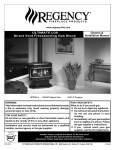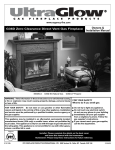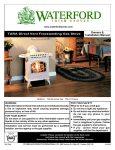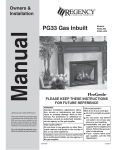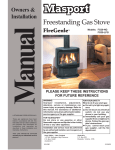Download Regency C34-LP2 Installation manual
Transcript
www.regency-fire.com C34 Classic Direct Vent Freestanding Gas Stove Owners & Installation Manual Classic C34 model shown above features optional gold plated door and gold legs. MODELS: C34-NG2 Natural Gas C34-LP2 Propane WARNING: If the information in these instructions are not followed exactly, a fire or explosion may result causing property damage, personal injury or loss of life. FOR YOUR SAFETY What to do if you smell gas: ® Do not try to light any appliance ® Do not touch any electrical switch: do not use any phone in your FOR YOUR SAFETY building. Do not store or use gasoline or other flammable vapors and ® Immediately call your gas supplier liquids in the vicinity of this or any other appliance. from a neighbour's phone. Follow the gas supplier's instructions. Installation and service must be performed by a qualified ® If you cannot reach your gas installer, service agency or the gas supplier. supplier, call the fire department. Tested by: Installer: Please complete the details on the back cover and leave this manual with the homeowner. Homeowner: Please keep these instructions for future reference. 908-584a FPI FIREPLACE PRODUCTS INTERNATIONAL LTD. 6988 Venture St., Delta, BC Canada, V4G 1H4 01/09/06 REGENCY Classic Direct Vent Freestanding Gas Stove To the New Owner: Congratulations! You are the owner of a state-of-the-art Gas Stove by Fireplace Products International Ltd. The Regency Gas Series of hand crafted appliances has been designed to provide you with all the warmth and charm of a woodstove, at the flick of a switch. The models C34G-NG/C34B-NG and C34G-LP/C34B-LP of this series have been approved by Warnock Hersey for both safety and efficiency. As it also bears our own mark, it promises to provide you with economy, comfort and security for many trouble free years to follow. Please take a moment now to acquaint yourself with these instructions and the many features of your CLASSIC Direct Vent Freestanding Gas Stove. INFORMATION FOR MOBILE/MANUFACTURED HOMES AFTER FIRST SALE This Regency product has been tested and listed by Warnock Hersey as a Direct Vent Room Heater to the following standards: CAN/CGA-2.17M91, ANSI Z21.88b-2003/CSA 2.33b-2003. This Direct Vent System Appliance must be installed in accordance with the manufacturer's installation instructions and the Manufactured Home Construction and Safety Standard, Title 24 CFR, Part 3280, or the current Standard of Fire Safety Criteria for Manufactured Home Installations, Sites, and Communities ANSI/NFPA 501A, and with CAN/CSA Z240-MH Mobile Home Standard in Canada. This appliance installation must comply with the manufacturer's installation instructions and local codes, if any. In the absence of local codes follow the current National Fuel Gas Code, ANSI Z223.1 and the current National Electrical Code ANSI/NFPA 70 in the U.S.A., and the current CAN/CGA B149 Gas Installation Code and the current Canadian Electrical Code CSA C22.1 in Canada. This Regency Mobile/Manufactured Home Listed appliance comes factory equipped with a means to secure the unit. This Regency Mobile/Manufactured Home listed appliance comes equipped with a dedicated #8 ground lug to which an 8 gauge copper wire from the steel chassis ground must be attached. 2 Regency CLASSIC C34-2 Direct Vent Freestanding Gas Heater TABLE OF CONTENTS Page Safety Label Safety Label ............................................................. 4 Installation Specifications ........................................................... 5 Before You Start ....................................................... 5 General Safety Information ......................................... 5 Installation Checklist ................................................. 6 Locating Your Classic Gas Stove ............................... 6 Manufactured Mobile Home Requirements ................... 6 Combustion and Ventilation Air .................................. 6 Clearances to Combustibles ...................................... 6 Optional Fan Installation ............................................ 7 Pedestal Assembly ................................................... 8 Leg and Bottom Shield Assembly ............................... 8 Venting ................................................................... 9 Installation Precautions ............................................. 9 Safety Precautions for the Installer ............................. 9 Vent Restrictor Position ............................................. 9 Exterior Vent Terminal Locations .............................. 10 Rigid Pipe Venting Components List ......................... 11 Rigid Pipe Venting Systems Horizontal and Vertical Terminations ................... 12 Venting Arrangements Horizontal Terminations (all Systems) ................. 13 Vertical Terminations (Dura-Vent) ....................... 13 Horizontal and Vertical Venting With Two Elbows ...... 14 DV Stove Horizontal Vent Kit 945-216 ....................... 15 DV Stove Horizontal Vent Kit 945-216 Installation ...... 15 Dura-Vent Termination Systems ............................... 17 Planning Your Dura-Vent Installation ......................... 17 Dura-Vent Venting Components ............................... 17 Dura-Vent Horizontal Installations ............................. 19 Dura-Vent Vertical Termination ................................. 20 Offset Chart ............................................................ 21 Cathedral Ceiling Installations .................................. 21 Converting a Class-A Metal Chimney or Masonry Chimney to a Direct Vent System ...................... 22 - Instructions for Converting a Factory Built Metal Chimney ............................................... 22 - Instructions for Converting a Masonry Chimney .. 23 System Data Table ................................................. 24 Regency CLASSIC C34-2 Direct Vent Freestanding Gas Heater Page Gas Connection ...................................................... High Elevation ......................................................... Gas Pressure Test .................................................. Valve Description .................................................... Log Set Installation ................................................. Door and Glass Frame ............................................ Door Handle ........................................................... Optional Remote Control Installation ......................... Remote Wall Switch................................................ Optional Wall Thermostat ........................................ Thermostat Wire Table ............................................ Final Check ............................................................ Wiring Diagram ....................................................... 24 24 24 24 25 25 26 26 26 26 26 26 27 Operating Instructions Operating Instructions ............................................. Lighting Procedure .................................................. Shutdown Procedure ............................................... First Fire ................................................................ Pilot Adjustment ..................................................... Aeration Adjustment ................................................ Copy of Lighting Plate Instructions ............................ Normal Operating Sounds of Gas Appliances ............ Thermopile/Thermocouple ........................................ 28 28 28 28 28 29 29 30 30 Maintenance Maintenance Instructions ......................................... General Vent Maintenance....................................... Log Replacement .................................................... Gold Plated Doors ................................................... Glass Gasket ......................................................... Glass Replacement ................................................. Removing Valve Assembly ....................................... Installing Valve Assembly ........................................ 30 30 30 31 31 31 31 31 Parts List Replacement/Spare Parts list ................................... 32 Warranty Warranty ................................................................ 35 3 SAFETY LABEL This is a copy of the label that accompanies each CLASSIC Direct Vent Freestanding Gas Stove. We have printed a copy of the contents here for your review. The safety label is located on the back panel. NOTE: Regency units are constantly being improved. Check the label on the unit and if there is a difference, the label on the unit is the correct one. For the State of Massachusetts, installation and repair must be done by a plumber or gasfitter licensed in the Commonwealth of Massachusetts. For the State of Massachusetts, flexible connectors shall not exceed 36 inches in length. For the State of Massachusetts, the appliances individual manual shut-off must be a t-handle type valve. 4 Regency CLASSIC C34-2 Direct Vent Freestanding Gas Heater INSTALLATION IMPORTANT: SAVE THESE INSTRUCTIONS The CLASSIC Direct Vent Freestanding Gas Stove must be installed in accordance with these instructions. Carefully read all the instructions in this manual first. Consult the building authority having jurisdiction to determine the need for a permit prior to starting the installation. - WARNING Failure to follow the instructions could cause a malfunction of the heater which could result in death, serious bodily injury, and/or property damage. Failure to follow these instructions may also void your fire insurance and/or warranty. Note: These instructions take precedence over Simpson Dura-Vent instructions SPECIFICATIONS Fuels: C34-NG is approved for use with natural gas. C34-LP is approved for use with liquefied petroleum gases (propane). Electrical: 120V. A.C. system. Optional circulation fan: Two speed, 125/ 75 CFM. Log Sets: Ceramic fibre, 4 per set. Vent System: Coaxial (6 5/8" outer/ 4" inner liner) rigid flue and termination cap. SHOULD OVERHEATING OCCUR, OR THE GAS SUPPLY FAIL TO SHUT OFF, SHUT OFF THE MANUAL GAS VALVE TO THE APPLIANCE BEFORE SHUTTING OFF THE ELECTRICAL SUPPLY. - WARNING Risk of fire or electric shock. Only qualified service personnel shall be used to install and provide maintenance of this appliance. BEFORE YOU START Safe installation and operation of this appliance requires common sense, however, we are required by the Canadian Safety Standards and ANSI Standards to make you aware of the following: THIS APPLIANCE SHOULD BE INSTALLED, REPAIRED, INSPECTED BEFORE USE AND AT LEAST ANNUALLY BY A QUALIFIED SERVICE PERSON. MORE FREQUENT CLEANING MAY BE REQUIRED DUE TO EXCESSIVE LINT FROM CARPETING, ETC. IT IS IMPERATIVE THAT THE CONTROL COMPARTMENT, BURNER AND CIRCULATING AIR PASSAGEWAYS OF THE APPLIANCE BE KEPT CLEAN. DUE TO HIGH TEMPERATURES, THE APPLIANCE SHOULD BE LOCATED OUT OF TRAFFIC AND AWAY FROM FURNITURE AND DRAPERIES. WARNING: FAILURE TO INSTALL THIS APPLIANCE CORRECTLY MAY CAUSE A SERIOUS HOUSE FIRE AND WILL VOID YOUR WARRANTY. CHILDREN AND ADULTS SHOULD BE ALERTED TO THE HAZARDS OF HIGH SURFACE TEMPERATURES, ESPECIALLY THE FIREPLACE GLASS, AND SHOULD STAY AWAY TO AVOID BURNS OR CLOTHING IGNITION. YOUNG CHILDREN SHOULD BE CAREFULLY SUPERVISED WHEN THEY ARE IN THE SAME ROOM AS THE APPLIANCE. CLOTHING OR OTHER FLAMMABLE MATERIAL SHOULD NOT BE PLACED ON OR NEAR THE APPLIANCE. be raised up on a platform to enhance its visual impact. If the appliance is going to be installed on carpeting, see clearances to combustibles on page 6. The CLASSIC Direct Vent Freestanding Gas Stove can be installed in a wide variety of ways and will fit nearly any room layout. It may be installed in a recessed position, framed out into the room, or across a corner. This appliance is Listed for Alcove installations, maintain minimum Alcove clearances as follows, minimum ceiling height of 65-11/16", minimum width of 48" and a maximum depth of 36". 3) The CLASSIC Direct Vent Freestanding Gas Stove is approved for alcove installations, which meet the clearances listed on page 6. This unit can be installed in a bedroom, when installed with a millivolt thermostat. This unit is approved for manufactured home installations, see page 13 for the required vent arrangements. If installed into a manufactured or mobile home the unit must be bolted down to the floor. 4) We recommend that you plan your installation on paper using exact measurements for clearances and floor protection before actually installing this appliance. Have a qualified building inspector review your plans before installation. GENERAL SAFETY INFORMATION 1) The appliance installation must conform with local codes or, in the absence of local codes, with the current Canadian or National Electrical Codes,CAN1-B149 or ANSI Z223.1 Installation Codes. 2) The appliance when installed, must be electrically grounded in accordance with local codes, or in the absence of local codes with the current National Electrical Code, ANSI/NFPA 70 or CSA C22.1 Canadian Electrical Code. 3) The appliance should be inspected for shipping damage before use and serviced annually by a professional service person. More frequent cleaning may be required due to excessive lint from carpeting, bedding material, etc. It is imperative that control compartments, and circulating air passageways of the appliance be kept clean. 1) Provide adequate clearances for servicing, proper operation and around the air openings into the combustion chamber. 4) See general construction and assembly instructions. The appliance and vent should be enclosed when installed in or passing through a living area. 2) The appliance may be installed on a flat, solid, continuous surface (e.g. wood, metal, concrete). This may be the floor, or it can 5) This appliance must be connected to the specified vent and termination cap to the outside of the building envelope. Regency CLASSIC C34-2 Direct Vent Freestanding Gas Heater 5 INSTALLATION 6) Never vent to another room or inside a building. Make sure that the vent is fitted as per the instructions starting on page 8. 7) Inspect the venting system annually for blockage and any signs of deterioration. 8) Venting terminals shall not be recessed into a wall or siding. 9) Any safety glass removed for servicing must be replaced prior to operating the appliance. 10) To prevent injury, do not allow anyone who is unfamiliar with the operation to use the fireplace. Emissions from burning wood or gas could contain chemicals known to the State of California to cause cancer, birth defects or other reproductive harm. 2) If required, adjusting the primary air to ensure that the flame does not carbon. First allow the unit to burn for 15-20 min. to stabilize. 3) Check for proper draft. CAUTION: Any alteration to the product that causes sooting or carboning that results in damage is not the responsibility of the manufacturer. LOCATING YOUR CLASSIC GAS STOVE When selecting a location for your stove, ensure that the clearances on this page are met as well as ensuring that there is adequate accessibility for servicing and proper operation. INSTALLATION CHECKLIST 1) Locate appliance, page 6, see Clearances to Combustibles, page 6. Check Venting Clearances, Vertical and Horizontal Termination requirements on pages 11 to 14. 2) Install Optional Fan, page 7. 3) Assemble stove base - pedestal or bottom shield and legs, page 8. 4) Install venting, either with the DV Stove Horizontal Vent Kit (page 15) or the DuraVent Termination kits (page 17). Check Vent Restrictor setting, page 9. If converting a Class-A Metal Chimney or Masonry Chimney to a Direct Vent system, see instructions on pages 22 and 23. 5) Make gas and electrical connections, page 24. Test the pilot. Must be as per diagram, pages 28. 6) Test gas pressure, page 24. 7) Install log set, see page 25. . 8) Install optional Wall Switch, Remote Control, or Wall Thermostat, page 26. 9) Final check, page 26. Before leaving this unit with the customer, the installer must ensure that the appliance is firing correctly and operation fully explained to customer. This includes: 1) Clocking the appliance to ensure the correct firing rate (rate noted on label) after burning appliance for 15 minutes. 6 CLEARANCES TO COMBUSTIBLES The clearances listed below are MINIMUM distances. Measure the clearance to both the appliance and the chimney connector. The farthest distance is correct if the two clearances do not coincide. For example, if the appliance is set as indicated in one of the diagrams but the back is too close, move the stove until the correct clearance to the back is obtained. This unit can be installed on a solid combustible surface like a wood floor. This unit can also be installed directly on carpeting or vinyl when the bottom pedestal cover plate (provided with the unit) is installed. This appliance may be installed only with the clearances as shown in the situations pictured. Do not combine clearances from one type of installation with another in order to achieve closer clearances. Use the minimum clearances shown in the diagrams below: A) B) C) D) E) F) Cross Corner Room Divider Island Flat on Wall Flat on Wall Corner Flush with Wall/Alcove C34 Clearance to Combustibles A Side Wall to Unit 10"/ 250 mm B Back Wall to Unit 6"/ 150 mm E Side Wall to Unit 1.5"/ 38 mm C34 Reference Dimensions C Back Wall to Flue Centerline 13"/ 330 mm D Side Wall to Flue Centerline 22"/ 559 mm F Side Wall to Flue Centerline 14"/ 356 mm For Vent Termination requirements, see pages 10 to 11. MANUFACTURED MOBILE HOME ADDITIONAL REQUIREMENTS 1) Ensure that structural members are not cut or weakened during installation. 2) Ensure proper grounding using the #8 ground lug provided. See page 7. 3) Appliance must be anchored to the floor. See page 8. COMBUSTION AND VENTILATION AIR The combustion air from this appliance is drawn from outside the building through the outer flue. Extra provision for combustion air is not required. Minimum ceiling height is 36" / 914 mm from top of unit. Minimum clearance to vent 1-1/4" (32mm). Regency CLASSIC C34-2 Direct Vent Freestanding Gas Heater INSTALLATION OPTIONAL FAN INSTALLATION For pedestal unit: To install the fan in an installed stove-access from front through the pedestal by following the directions below. If the stove is not installed - access through rear and follow steps 4 to 17. 2) Remove valve cover plate by removing 2 screws. 3) Remove wire from piezo ignitor. 4) Screw the four 8-32 x3/4 screws provided into the nutserts as shown in diagram 3. Do not tighten screws. 5) Push all the fan wires through the hole on the fan assembly. See diagram 2. 9) Lift the fan assembly in through the pedestal and up through the cut out as shown in diagrams 3 and 4. For leg unit: remove 7 screws, remove bottom access panel and install fan assembly, follow steps 4 to 17. IMPORTANT Disconnect power supply before servicing Diagram 2 1) Open pedestal door and remove door cover plate by removing 4 screws. See diagram 1. 6) Put power cord (shown in diagram 3) through the hole and pull through to the front of the unit for easier installation of ground wire. Diagram 3 7) Place the fan assembly partially in door cover plate hole. See diagram 2. 8) Attach the 2 ground wires (green) to the ground lug as per diagram 2. Note: Ground lug is located on the bottom of the fan assembly. See diagram 2. Diagram 1 Diagram 4 Caution: Ensure that the wires do not touch any hot surfaces. Note: The #8 ground lug is a dedicated ground for mobile home use only. Regency CLASSIC C34-2 Direct Vent Freestanding Gas Heater 7 INSTALLATION 10) Put the insulation gasket on the back of the fan. Line up the keyhole slots with the matching screws and pull back slightly to lock into place. While holding fan assembly in place, tighten screws. 11) Remove the dummy plug from the right side of the bottom shield or pedestal and install the supplied fan switch. 12) Attach the hot wire from power cord to the thermodisc. PEDESTAL ASSEMBLY 1) For easier assembly, tip the stove on its back (preferably onto a soft surface to prevent scratching). 2) Unscrew the 4 bolts in the underside of the stove. Align the holes in the corners of the pedestal top with the corresponding holes in the base of the stove. Use washers which are supplied with the pedestal as shown in diagram. Reinstall bolts. 13) Slide thermodisc under the thermodisc bracket. LEG AND BOTTOM SHIELD ASSEMBLY These instructions apply to the steel leg, painted cast leg and the gold plated cast leg. It will be easier to attach the legs to the stove if it is tipped on its back (preferably on a soft surface to prevent scratching). 1) Remove the 4 bolts in the underside of the base and discard. 2) Slide the bolt and washer (supplied with the bottom shield) through the leg, then slide the bottom shield in between the leg and the base of the stove. Tighten the bolts. 14) Connecting wires to the 3 way switch: a. Connect the red wire from the fan to the top of the 3 way switch. b. Connect black wire from fan to the bottom of the 3 way switch. c. Connect white jumper wire to middle of the three way switch. See wiring diagram below. 3) Hook up the Burner ON/OFF switch. 4) Level the stove by adjusting the levelling bolts in the bottom of each leg. 15) Connect white wire from fan motor to neutral on the power cord. 16) Pull power wire back and put strain relief grommet in place as per diagram 4. 17) Reverse steps 3-1 to complete installation. Fan Removal 1) Disconnect the power to the fan. 2) Allow the stove to cool to room temperature. 3) Open the pedestal door and remove the screws on the door cover plate. (Leg units: remove the bottom access panel.) 3) Hook up wires to Burner ON/OFF switch and valve assembly (be careful not to pinch wires). See diagram above. 4) Loosen the screws of the nutserts. 5) Remove the fan assembly from the key slots at the fan base and pull fan out through the rectangular opening. (Diagram 3). 6) Turn fan 90 degrees. (Diagram 2). (Pedestal units only). 4) Push the Regency logo into the two holes in the front bottom left corner of the pedestal cover plate. Anchoring Brackets Hold Down Package Part# 846-585 Note: Any paint touch up should be done prior to placing logo on pedestal. 7) Disconnect the green ground wires to the grounding lug. 8) Disconnect the white wire of the fan from the power cord. 9) Disconnect the red wire and black wire (from fan to Fan Switch). 10) Take fan out from the stove body. (Diagram 1). 8 Regency CLASSIC C34-2 Direct Vent Freestanding Gas Heater INSTALLATION VENTING INTRODUCTION INSTALLATION PRECAUTIONS VENT RESTRICTOR POSITION The DV Stove Horizontal Vent Kit and the Simpson Dura-Vent Direct Vent System Model DV-GS venting systems, in combination with the Classic Direct Vent Freestanding Gas Stove, C34B-NG/C34G-NG and C34B-LP/C34G-LP, have been tested and listed as direct vent heater systems by Warnock Hersey. These venting systems are engineered products that have been designed and tested for use with the C34B-NG/C34G-NG and the C34BLP/C34G-LP. The warranty will be voided and serious fire, health or other safety hazards may result from any of the following actions: Vent restriction is required for certain venting installations, see the diagrams on page 13 to determine if they are required for your installation. If converting a Class-A Metal Chimney or Masonry Chimney to a Direct Vent system, see instructions on pages 22 and 23. The C34 uses the "balanced flue" technology Co-Axial system. The inner liner vents products of combustion to the outside while the outer pipe draws outside combustion air into the combustion chamber thereby eliminating the need to use heated room air for combustion and losing warm room air up the chimney. Note: These flue pipes must not be connected to any other appliance. The gas appliance and vent system must be vented directly to the outside of the building, and never be attached to a chimney serving a separate solid fuel or gas burning appliance. Each direct vent gas appliance must use it's own separate vent system. Common vent systems are prohibited. IMPORTANT Read all instructions carefully before starting the installation. Failure to follow these instructions may create a fire or other safety hazard, and will void the warranty. Be sure to check the venting and clearance to combustible requirements. Consult your local building codes before beginning installation. The location of the termination cap must conform to the requirements in the Exterior Vent Terminal Locations diagram on page 10. 1) Installation of any damaged Direct Vent component The vent restrictor has three settings: "C" Center (factory setting), "L" Left, and "R" Right. Simply loosen the screws and push the vent restrictor plate to the correct position. Tighten the screws. 2) Unauthorized modification of the Direct Vent System 3) Installation of any component part not manufactured or approved by Simpson DuraVent or Fireplace Products International Ltd. 4) Installation other than as instructed by Simpson Dura-Vent and Fireplace Products International Ltd. Warning: Always maintain required clearances (air spaces) to nearby combustibles to prevent a fire hazard. Do not fill air spaces with insulation. Be sure to check the vent termination clearance requirements from decks, windows, soffits, gas regulators, air supply inlets and public walkways as specified in the Exterior Vent Terminal Locations on page 10 and in your local building codes. The gas appliance and vent system must be vented directly to the outside of the building, and never be attached to a chimney serving a separate solid fuel or gasburning appliance. Each direct vent gas appliance must use it's own separate vent system. Common vent systems are prohibited. SAFETY PRECAUTIONS FOR THE INSTALLER 1) Wear gloves and safety glasses for protection. 2) Exercise extreme caution when using ladders or on roof tops. 3) Be aware of electrical wiring locations in walls and ceilings. Regency CLASSIC C34-2 Direct Vent Freestanding Gas Heater 9 10 H= *Not to be installed above a meter/regulator assembly within 36" (90 cm) horizontally from the centre-line of the regulator. J= clearance to service regulator vent outlet [*min. 36" (90cm)] K= clearance to non-mechanical air supply inlet to building or the combustion air inlet to any other appliance [*12 inches] L= clearance to a mechanical air supply inlet [*min. 72" (1.8 m) M= **clearance above paved side-walk or a paved driveway located on public property [*84" (2.1 m) min.] N=clearance under veranda, porch,, deck, or balcony [*12" (30 cm) min.***] *As specified in CGA B149 or ANZI 223.1 Installation Codes. Note: local Codes or Regulations may require different clearances. **A vent shall not terminate directly above a side-walk or paved driveway which is located between two single family dwellings and serves both dwellings ***Only permitted if veranda, porch, deck or balcony, is fully open on a minimum of 2 sides beneath the floor. A= Clearance above grade, veranda, porch, deck, or balcony [*12" (30 cm) min.] B= Clearance to window or door that may be opened [*12" (30cm)] C= Clearance to permanently closed window min. 12" (30 cm) D= Vertical clearance to ventilated soffit located above the terminal within a horizontal distance of 24" (60 cm) from the centre-line of the terminal [18" (46 cm) min.] E= Clearance to unventilated soffit [12" (30 cm) min.] F= Clearance to outside corner: with AstroCap Termination Cap (min 6"/15cm), with Dura-Vent Termination Cap (12"/30cm) G= Clearance to inside corner: with AstroCap Termination Cap (min 6"/15cm), with DuraVent Termination Cap (12"/30cm) INSTALLATION EXTERIOR VENT TERMINAL LOCATIONS Regency CLASSIC C34-2 Direct Vent Freestanding Gas Heater INSTALLATION RIGID PIPE VENTING COMPONENTS LIST All Simpson Dura-Vent components are available directly from FPI. Description Amerivent R Direct Vent Simpson Dura-Vent Direct VentGSR Selkirk Direct-TempTM 6" Pipe Length, Galvanized 6" Pipe Length, Black 7" Pipe Length, Galvanized 7" Pipe Length, Black 9" Pipe Length, Galvanized 9" Pipe Length, Black 12" Pipe Length, Galvanized 12" Pipe Length, Black 18" Pipe Length, Galvanized 18" Pipe Length, Black 24" Pipe Length, Galvanized 24" Pipe Length, Black 36" Pipe Length, Galvanized 36" Pipe Length, Black 48" Pipe Length, Galvanized 48" Pipe Length, Black 908 908B N/A N/A 907 907B 906 906B N/A N/A 904 904B 903 903B 902 902B 4DT-6 4DT-6B N/A N/A 4DT-9 4DT-9B 4DT-12 4DT-12B 4DT-18 4DT-18B 4DT-24 4DT-24B 4DT-36 4DT-36B 4DT-48 4DT-48B N/A N/A 4D7 4D7B N/A N/A 4D12 4D12B N/A N/A 4D2 4D2B 4D3 4D3B 4D4 4D4B Adjustable Length, 11"-14", Galv. Adjustable Length, 11"-14", Black Adjustable Length, 17"-24", Black Adjustable Length, 7" Galvinized Adjustable Length, 7" Black Adjustable Length, 12" Galvinized Adjustable Length, 12" Black 911 911B 917B N/A N/A N/A N/A 4DT-AJ 4DT-AJB N/A N/A N/A N/A N/A N/A N/A N/A 4D7A 4D7AB 4D12A 4D12AB 45O 45O 45O 45O 90O 90O 90O 90O 945 945B 945G 945BG 990 990B 990G 990BG 4DT-EL45 4DT-EL45B N/A N/A 4DT-EL90S 4DT-EL90SB N/A N/A 4D45L 4D45LB N/A N/A 4D90LS 4D90LBS N/A N/A Ceiling Support Cathedral Support Box Wall Support/Band Offset Support Wall Thimble, Black Wall Thimble Support Box/Ceiling Support Firestop Spacer Trim Plate, Black Brass Trim for Wall Thimble/Ceiling Support 949 - n/a from FPI 941 988 989 - n/a from FPI 942 940 963 N/A 3951 4DT-CS 4DT-CSS 4DT-WS/B 4DT-OS 4DT-WT N/A 4DT-FS 4DT-TP N/A 4DFSP 4DRSB 4DWS N/A 4DWT N/A 4DFSP 4DFPB N/A Attic Insulation Shield 12" Attic Insulation Shield - Cold Climates 36" N/A N/A N/A N/A 4DAIS12 4DAIS36 Basic Horizontal Termination Kit (A) Horizontal Termination Kit (B) Vertical Termination Kit 970 971 978 4DT-HKA 4DT-HKB 4DT-VKC 4DHTK2 4DHTK1 4DVTK High Wind Vertical Cap High Wind Horizontal Cap Horizontal Square Termination Cap Verical Termination Cap Storm Collar 991 985 984 980 953 N/A N/A 4DT-HHC 4DT-HVC 4DT-SC N/A N/A 4DHC 4DVC 4DSC Adjustable Flashing, 0/12-6/12 Adjustable Flashing, 6/12-12/12 943 943S 4DT-AF6 4DT-AF12 4DF 4DF12 Vinyl Siding Standoff Vinyl Siding Shield Plate 950 N/A 4DT-VS 4DT-VSP N/A N/A Snorkel Termination 14" Snorkel Termination 36" 982 981 4DT-ST14 4DT-ST36 4D12S 4D36S Elbow, Galvinized Elbow, Black Elbow, Swivel, Galvinized Elbow, Swivel, Black Elbow, Galvinized Elbow, Black Elbow, Swivel, Galvinized Elbow, Swivel, Black 946-506/P 640-530/P 946-205 Vent Guard (Optional) Riser Vent Terminal Vinyl Siding Shield for Riser Vent Terminal Regency CLASSIC C34-2 Direct Vent Freestanding Gas Heater 946-208/P 946-523/P 946-206 Vent Guard (Optional) - Riser Vent Terminal AstroCap Horizontal Cap Vinyl Siding Standoff - AstroCap 11 INSTALLATION RIGID PIPE VENTING SYSTEMS Horizontal or Vertical Terminations Alternate Horizontal Termination Caps WARNING: Do not combine venting components from different venting systems. However use of the the AstroCapTM and FPI Riser is acceptable with all systems. This product has been evaluated by Intertek for using a Dura-Vent Flue Adaptor in conjunction with Selkirk Direct-Temp and Ameri Vent Direct venting systems. Use of these systems with the Direct Vent GS starting collar is deemed acceptable and does not affect the Intertek WHI listing of components. When using piping other than Simpson Dura-Vent, 3 screws must be used to secure rigid pipe to adaptor. The FPI AstroCapTM and FPI Riser Vent terminal is certified for installations using FPI venting systems as well as Simpson Dura-Vent®, Direct Vent GS, American Metal Products, Ameri Vent Direct vent and Selkirk Direct-Temp. FPITM, and FPI AstroCapTM are the proprietary trademarks of FPI Fireplace Products International Ltd. Dura-Vent® and Direct Vent GS are registered and/or proprietary trademarks of Simpson Dura-Vent Co. Inc. 12 Regency CLASSIC C34-2 Direct Vent Freestanding Gas Heater INSTALLATION VENTING ARRANGEMENTS HORIZONTAL TERMINATIONS FOR ALL VENTING SYSTEMS The shaded areas in the diagram below show all allowable combinations of vertical runs with horizontal term-inations. Maximum one 90 O elbow (two 45 o elbows equal one 90 o elbow). Propane and Natural Gas: Residential, Manufactured and Mobile Homes Installations The venting arrangements diagrammed below, have a min. of 75% (flue loss) efficiency with Fan Off, as required for manufactured homes. (Actual efficiency may be as high as 85%) VENTING ARRANGEMENTS VERTICAL TERMINATION SYSTEMS FOR RESIDENTIAL MANUFACTURED AND MOBILE HOMES The shaded area in the diagram below shows all allowable combinations of straight vertical and offset to vertical runs with vertical terminations. Maximum two 45 o elbows. All vertical and offset to vertical vent installations require Vent Restrictor Position "R" (Right). If the vent is ENCLOSED in a chase (min. size 9" x 9") maintain a 1-1/4" clearance to combustibles. May be installed in Manufactured (Mobile) Homes after first sale. May be installed in Manufactured (Mobile) Homes after first sale. Straight Vertical and Offset to Vertical Terminations use Vent Restrictor Position "R" (Right) NOTE: See page 9 for installation instructions for the Vent Restrictor Position. Venting Arrangements Examples: Example A) Venting has a horizontal termination. A 7 ft. vertical run with 6 ft. horizontal run does not fall within the shaded area, and therefore is an allowable installation with the factory set vent restrictor position of "C". Example B) Offset to Vertical Vent. A 15 ft. vertical run with 4 ft. horizontal offset distance falls within the shaded area and is an allowable installation with Vent Restrictor Position "R" (Right). Regency CLASSIC C34-2 Direct Vent Freestanding Gas Heater 13 INSTALLATION Horizontal Venting with Two (2) 90o Elbows One 90o elbow = Two 45o elbows. Option V A) 4' Min. B) 5' Min. C) 6' Min. H + H1 6' Max. 7' Max. 8' Max. With these options, maximum total pipe length is 30 feet with minimum of 6 feet total vertical and maximum 8 feet total horizontal. Please note minimum 1 foot between 90o elbows is required. Lengths do not include elbow indicated. Vent restrictor position C (fully open), refer to page 9. Vertical Venting with Two (2) 90o Elbows One 90o elbow = Two 45o elbows. Option A) B) C) D) E) V 1' Min. 2' Min. 3' Min. 4' Min. 5' Min. H 4' Max. 5' Max. 6' Max. 7' Max. 8' Max. V + V1 2' Min. 3' Min. 4' Min. 5' Min. 6' Min. With these options, max. total pipe length is 30 feet with min. of 6 feet total vertical and max. 8 feet total horizontal. Please note min. 1 foot between 90o elbows is required. Lengths do not include elbow indicated. Vent restrictor position C (fully open), refer to page 9. 14 Regency CLASSIC C34-2 Direct Vent Freestanding Gas Heater INSTALLATION DV STOVE HORIZONTAL VENT KIT DV 2 ft. Stove Vent Kit (Part # 946-116) and DV 4 ft. Stove Vent Kit (946-216) include all the parts needed to install the C34 with minimum horizontal and vertical vent dimensions. For installations that require longer vertical and/or horizontal vents use the Dura-Vent system as shown on page 17. Qty. Description 1 Rigid Pipe Section (Kit # 946-116: 2 ft. (1.2m) length, Kit # 946-216: 4 ft. (1.2m) length), 6-1/2" (165mm) inside diameter 2) 1 Flex Liner, compressed aluminium 2 ply liner, 4" (102mm) inside diameter 3) 4 spring spacers 4) 1 90 deg. Elbow 5) 1 Adjustable pipe section 13-1/2" to 24" (343mm x 610mm), 2 pieces 6) 1 Thimble Cover 7) 1 Wall Thimble (2 pcs.) 8) 1 Adapter 9) 1 AstroCap Termination Cap 10) 2 Trim Collar 11) 1 tube of Mill-Pac, high temperature sealant 12) 12 Screws, #8 x 1/2" Self tapping, Stainless Steel 13) 14 Screws, #8 x 1/2" Self tapping, Black 14) 4 Screws #8 x 1-1/2" Drill Point, Black 15) 4 Screws #8 x 1-1/2" Drill Point, Stainless Steel 16) 8 Wood screws #8 x 1" 1) Optional: 946-206 Vinyl Siding Standoff for AstroCap Note: a) Liner sections should be continuous without any joints or seams. b) This is an approved system, therefore components in this system must not be substituted for any other manufacturer's products. DV STOVE HORIZONTAL VENT KIT (#946-116 & #946-216) INSTALLATION Review the following sequence of instructions which are typical of most installations. The sequence may vary depending on wall thickness. sure snow is not directed towards vent termination area. Refer to pages 6 to 10 for vent location and clearance dimensions. 1) Set the unit in its desired location. Check to determine if wall studs will be in the way of the venting system, adjust location until all clearances are met and there are no obstructions. Note: A 1-1/2"(38mm) clearance around the outer pipe must be maintained except that only a 1" (25mm) clearance is needed at the termination end. IMPORTANT: Do not locate termination hood where excessive snow or ice buildup may occur. Be sure to check vent termination area after snow falls, and clear to prevent accidental blockage of venting system. When using snow blowers, make Regency CLASSIC C34-2 Direct Vent Freestanding Gas Heater 2) Assemble a trial fit to determine the vertical center-line for the vent termination. a) Cut a 9-1/2" x 9-1/2" (241mm x 241 mm) square hole on both the interior and exterior wall. b) Install wall thimbles on both interior and exterior wall with 4 wood screws (#8 x 1") per thimble. c) Attach the 2 piece adjustable pipe section to the vent terminal and slide into position from the exterior. The larger diameter end of the adjustable pipe goes to the vent terminal. d) Install the 90o elbow onto the adjustable pipe to determine the vertical centerline of the starter collar on the unit. Note: if the centerline cannot be met, the adjustable sections will have to be cut. 15 INSTALLATION e) Cut the 2 ft. or 4 ft. section of rigid pipe to length. Ensure that the pipe length when cut will seat onto both the starter collar and the 90o elbow. Crimped section of rigid pipe seats into the 90 o elbow. Only cut the uncrimped side of pipe. Dismantle all pipe sections including vent terminal. 3) Attach the 4" dia. flex liner to the vent terminal ensuring that the flex overlaps the collar of the vent terminal by a minimum of 1-3/8"(35mm). Use Mill-Pac to seal and secure with 3 of the #8 x 1/2" screws (stainless steel). 4) Attach the adjustable pipe section to the vent terminal using Mill-Pac and/or high temperature silicone and attach with 3 of the #8 x 1/2" screws (stainless steel). Hint: Apply the sealant (Mill-Pac and/or high temperature silicone) to the outer pipe before connecting the inner pipe. Note: The pipe seam should be facing down. Note: To make the installation more aesthetically pleasing, we recommend framing out a square that the cap can be mounted on. Note: The four screws provided for the vent cap should be replaced with appropriate fasteners for stucco, brick, concrete, or other types of sidings. 6) A bead of non-hardening mastic should be run around both the termination and vinyl siding standoff to prevent water from entering and to make a tight seal between the cap and the standoff. 7) Stretch the 4" dia. flex liner out fully and get a trial fit of the liner onto the 4" dia. starter collar. 8) Cut the 4" dia. flex liner to the desired size. Hint: leave an extra 12" to 16" of length, this will make the final assembly easier to work with. Note: If installing termination on a siding covered wall, a vinyl siding standoff or furring strips must be used to ensure that the termination is not recessed into the siding. For vinyl siding standoff installation refer to the Dura-Vent Termination instructions. 5) Slide the partially connected pipe and vent terminal assembly through the wall thimbles (from the exterior into the interior) and secure the cap to the exterior wall with 4 of the supplied screws (#8 x 1-1/2" drill point, stainless steel). Note: pilot holes will need to be drilled through the wall thimble on all 4 corners. 16 9) Secure the 4" dia. flex liner to the 4" adapter with Mill-Pac and 3 of the #8 x 1/2" screws (stainless steel). 12) Install the spring spacers onto the pipe sections. 13) Secure the 4" dia. flex liner with adapter onto the stove collar. Put a bead of Mill-Pac around the appliance adapter and secure with 3 screws (#8 x 1/2, stainless steel). 14) Attach the pipe section onto the starter collar by sealing with Mill-Pac and/or high temperature silicone and securing with 3 of the #8 x 1/2" (black) screws. Pipe seams should be facing the wall. 15) Attach the 90o elbow onto the pipe section by sealing with Mill-Pac and/or high temperature silicone and securing with 3 of the #8 x 1/2" screws (black). 16) Slide the adjustable pipe section onto the 90o elbow. The flex may have to be compressed back in order for the adjustable pipe to properly mate to the elbow. Seal with Mill-Pac and/or high temperature silicone and secure with 3 of the #8 x 1/2" screws (black). Pipe seams facing down. 10) Slide the decorative Thimble Cover over the pipe sections and secure with 4 screws (#8 x 1-1/2" drill point, black) to the wall. 17) Install the trim collar over the starter collar and secure with a #8 x 1/2" screw (black). Slide the trim collar over the adjustable pipe sections to cover the joint of the telescopic section. If the pipe needs to be touched up, use only Stove Brite High Temperature Metallic Black Stove Paint. 11) Slide the 90o elbow (crimp end up) and the 2 ft. or 4 ft. pipe section (crimp end up) over the 4" dia. flex liner. NOTE: All inner joints must be sealed with Mill-Pac. All outer joints may be sealed with high temperature silicone. Regency CLASSIC C34-2 Direct Vent Freestanding Gas Heater INSTALLATION DURA-VENT TERMINATION KIT Planning Your Dura-Vent Installation There are two basic types of Dura-Vent Direct Vent System installations: horizontal termination and vertical termination. Confirm the maximum horizontal run and maximum vertical rise from the diagrams on page 13. DURA-VENT VENTING COMPONENTS The Simpson Dura-Vent Direct Vent System offers a complete line of component parts for installation of both horizontal and vertical installation. Many items are offered in decorative black, as well as galvanized finish. The galvanized pipe and fittings are used for concealed locations such as attics or where corrosion is a factor, such as above the roof line. Decorative brass trim kits are available for both wall thimbles and ceiling support boxes. Part # Description 971 Horiz. Termination Kit includes: 90o black elbow, wall thimble cover, horiz. termination cap, 24" black pipe, 11" -14" 5/8" adjustable black pipe 970 Basic Horiz. Termination Kit includes: 90o black elbow, wall thimble cover, horiz. square term. cap 978 Vert. Termination Kit includes 0/12 - 6/12 pitch adjustable flashing, storm collar, low profile term. cap 908B 907B 906 906B 904 904B 903 903B 902 902B 911B 917B 6" Pipe Length-Black 9" Pipe Length-Black 12" Pipe Length Galv. 12" Pipe Length-Black 24" Pipe Length Galv. 24" Pipe Length-Black 36" Pipe Length Galv. 36" Pipe Length-Black 48" Pipe Length Galv. 48" Pipe Length-Black 11"-14 5/8" Adj. Pipe Length-Black 17"- 24" Adj. Pipe Length Black The minimum clearance of 1-1/4" (32mm) is required between the outer wall of the vent pipe and nearby combustible surfaces. Be sure to check the vent termination clearance requirements from decks, windows, soffits, gas regulators, air supply inlets and public walkways as specified in the Exterior Vent Terminal Locations on page 10 and in your local building codes. 945 945B 945G 945BG 990 990B 990G 990BG 45O Elbow Galv. 45O Elbow-Black 45O Elbow-Swivel Galv. 45O Elbow-Swivel-Black 90O Elbow Galv. 90O Elbow-Black 90O Elbow-Swivel Galv. 90O Elbow-Swivel-Black To determine the length of vent pipe required for vertical installations, measure the distance from the unit flue outlet to the ceiling, the ceiling thickness, the vertical rise in an attic or second storey, and allow for sufficient vertical height above the roof line. 991 980 984 985 982 981 High Wind Term. Cap (Vertical) Vertical Term. Cap Horiz. Sq. Term. Cap Horiz. Sq. High Wind Termination Cap Snorkel-14" Rise Term.Cap Snorkel-36" Rise Term.Cap For multi-storey applications, fire stops are required at each floor level. If an offset is needed, additional pipe, elbows and supports will be required. 940 941 3951 963 943 943S 953 950 988 942 Wall Thimble-Support/Box Cathedral/Ceiling-Support/Box Brass Trim for Wall Thimble & Ceiling Support Firestop Spacer Flashing 0/12-6/12 Flashing 7/12-12/12 Storm Collar Vinyl Siding Standoff Wall Strap Wall Thimble When planning your installation, it will be necessary to select the proper length of vent pipe for your particular requirements. For horizontal installations, determine the minimum clearance from the rear of the unit to the wall. It is also important to note the wall thickness. (The wall thimble is suitable for 2 x 4 or 2 x 6 wall construction.) Select the amount of vertical rise desired for "vertical-to-horizontal" type installations. Warning: Always maintain required clearances (air spaces) to nearby combustibles to prevent a fire hazard. Do not fill air spaces with insulation. Do not exceed the maximum number of elbows. One 90o for horizontal terminations and two 45o for vertical termination. Parts not supplied by DuraVent 946-506/P Vent Guard (Optional) 640-530/P Riser Vent Terminal (Optional) 946-205 Vinyl Siding Shield for Riser Vent Terminal 946-208 Vent Guard for Riser Vent Terminal Regency CLASSIC C34-2 Direct Vent Freestanding Gas Heater 17 INSTALLATION You will require the following Dura-Vent venting components with your new CLASSIC Direct Vent Freestanding Gas Stove. Please review your product to make sure you have everything you need. In the event that you are missing any part, contact your dealer. Note: These are the minimum components required. Other parts may be required for your particular installation. See page 11 for a venting components list. If installing termination on a siding covered wall, a vinyl siding standoff or furring strips can be used in order to ensure that the termination is not recessed into siding. The vinyl siding standoff is required for walls with vinyl siding. Dura-Vent Basic Horizontal Kit # 970 1 90o Elbow 1 Wall Thimble Cover 1 Horiz. Sq. Term. Cap Minimum components for a Horizontal Installation using Dura-Vent Components: A) Dura-Vent Horizontal Termination Kit #971 B) Wall Thimble #942 (required for combustible walls) (Canada Only) Minimum components for a Vertical Termination using Dura-Vent Components: D) Vertical Termination Kit # 978 See page 11 for pipe lengths). Alternate Horizontal Termination Caps Alternate Snorkel Termination Cap Part# 982 (14") Part# 981 (36") Alternate Horizontal Riser Vent Terminal Part# 640-530/P The Regency AstroCapTM is certified for installations using FPI venting systems as well as Simpson Dura-Vent® and Direct Vent GS. RegencyTM, and Regency AstroCapTM are the proprietary trademarks of FPI Fireplace Products International Ltd. Dura-Vent® and Direct Vent GS are registered and/or proprietary trademarks of Simpson Dura-Vent Co. Inc. 18 Regency CLASSIC C34-2 Direct Vent Freestanding Gas Heater INSTALLATION DURA-VENT HORIZONTAL INSTALLATIONS 1) Set the unit in its desired location. Check to determine if wall studs or roof rafters are in the way when the venting system is attached. If this is the case, you may want to adjust the location of the unit. 3) With the pipe attached to the stove, slide the stove into its correct location, and mark the wall for a 10" x 10" (inside dimensions) square hole. The center of the square hole should line up with the center-line of the horizontal pipe, as shown in diagram 2. Cut and frame the 10 inch square hole in the exterior wall where the vent will be terminated. If the wall being penetrated is constructed of non-combustible material, i.e. masonry block or concrete, a 7" diameter hole is acceptable. 2) Direct Vent pipe and fittings are designed with special twist-lock connections to connect the venting system to the appliance flue outlet. A twist-lock appliance adaptor is installed on the unit at the factory. Assemble the desired combination of pipe and elbows to the appliance adaptor with pipe seams oriented towards the wall or ceiling, as much out of view as possible. The final positioning of the pipe and 90o elbow assembly is determined by the mounting orientation of the adaptor on the stove and twist-locked for a solid connection. Note: a) Twist-lock procedure: Four indentations, located on the female ends of pipes and fittings, are designed to slide straight onto the male ends of adjacent pipes and fittings, by orienting the four pipe indentations so they match and slide in to the four entry slots on the male ends (diagram 1). Push the pipe sections completely together, then twist-lock one section clockwise approximately one-quarter turn, until the two sections are fully locked. The female locking lugs will not be visible from the outside on the Black Pipe or fittings. They may be located by examining the inside of the female ends. Apply sealant "Mill-Pac" to inner pipe and high temperature silicone sealant to outer pipe on every twist-lock joint. Diagram 1 Hint: Apply silicone to female end. *Diagram 3, 3a & 4: As specified in CGA B149 Installation Code. Local codes or regulations may require different clearances. Diagram 3 Note: Riser Vent is only for use in above grade terminations. Diagram 2 Note: a) The horizontal run of vent must be level, or have a 1/4 inch rise for every 1 foot of run towards the termination. Never allow the vent to run downward. This could cause high temperatures and may present the possibility of a fire. b) The location of the horizontal vent termination on an exterior wall must meet all local and national building codes, and must not be blocked or obstructed. For External Vent Terminal Locations, see diagram on page 10. c) Snorkel Terminations: For installations requiring a vertical rise on the exterior of the building, 14-inch and 36-inch tall Snorkel Terminations as shown in Diagram 3 are available, as well as the standard Riser Vent, see Diagram 3a. Follow the same installation procedures as used for standard Horizontal Termination. NEVER install the snorkel upside down. Diagram 3a Below Grade Installation If the Snorkel Termination must be installed below grade, i.e. basement application, proper drainage must be provided to prevent water from entering the Snorkel Termination. Refer to Diagram 4. Do not attempt to enclose the Snorkel within the wall, or any other type of enclosure. Diagram 4 b) Horizontal runs of vent must be supported every three feet. Wall straps are available for this purpose. Regency CLASSIC C34-2 Direct Vent Freestanding Gas Heater 19 INSTALLATION penetrate the roof. Determine if ceiling joists, roof rafters or other framing will obstruct the venting system. You may wish to relocate the appliance or to offset, as shown in diagram 9 to avoid cutting load bearing members. 4) Attach the Vinyl Siding Standoff (if required) to the Horizontal Vent Termination, but first run a bead of non-hardening mastic around its outside edges, so as to make a seal between vent cap and the standoff. Install the Vinyl Siding Standoff (Part # 950) between the vent cap and the exterior wall and attach with the four wood screws provided. Seal around the Vinyl Siding Standoff on all four sides. Diagram 5. The arrow on the vent cap should be pointing up. Insure that the 1-1/4" clearances to combustible materials are maintained. See diagram 5. Diagram 6 7) Install Wall Thimble in the center of the 10" square and attach with wood screws (in Canada). Diagram 9 3) To install the Round Support Box/Wall Thimble in a flat ceiling, cut a 10 inch square hole in the ceiling centered on the hole drilled in Step 2. Frame the hole as shown in diagram 10. 8) Slide the decorative wall thimble up to the wall surface being careful not to scratch the paint and attach with screws provided. Apply decorative brass or chrome trim if desired. See diagram 7. Diagram 5 Note: If installing termination on a siding covered wall, a vinyl siding standoff or furring strips must be used to ensure that the termination is not recessed into the siding. The four wood screws provided should be replaced with appropriate fasteners for stucco, brick, concrete, or other types of sidings. 5) Before connecting the horizontal run of vent pipe to the vent termination, slide the black decorative wall thimble cover over the vent pipe, then slide the Wall Thimble (Part # 942) over the vent pipe. 6) Slide the appliance and vent assembly towards the wall carefully inserting the vent pipe into the vent cap assembly. It is important that the vent pipe extends into the vent cap a sufficient distance so as to result in a minimum pipe overlap of 1-1/4 inches. Secure the connection between the vent pipe and the vent cap by attaching the two sheet metal strips extending from the vent cap assembly into the outer wall of the vent pipe. Use the two sheet metal screws provided to connect the strips to the pipe section. Bend any remaining portion of the sheet metal strip back towards the vent cap, so it will be concealed by the decorative wall thimble cover. See diagram 6. 20 Diagram 10 Diagram 7 VERTICAL TERMINATION 1) Maintain the 1-1/4" clearances (air spaces) to combustibles when passing through ceilings, walls, roofs, enclosures, attic rafter, or other nearby combustible surfaces. 4) Assemble the desired lengths of black pipe and elbows necessary to reach from the appliance adaptor up though the Round Support Box. Ensure that all pipes and elbow connections are in the fully twistlocked position and sealed. 5) Cut a hole in the roof centered on the small drilled hole placed in the roof in Step 2. The hole should be of sufficient size to meet the minimum requirements for clearance to combustibles of 1-1/4". Slip the flashing under the shingles (shingles should overlap half the flashing) as per diagram 11. Do not pack air spaces with insulation. Check page 13 for the maximum vertical rise of the venting system and the maximum horizontal offset limitations. 2) Set the gas appliance in its desired location. Drop a plumb bob down from the ceiling to the position of the appliance flue exit, and mark the loca- Diagram 8 tion where the vent will penetrate the ceiling. Drill a small hole at his point. Next, drop a plumb bob from the roof to the hole previously drilled in the ceiling, and mark the spot where the vent will Diagram 11: The upper half of the flashing is installed under the roofing material and not nailed down until the chimney is installed. This allows for small adjustments. 6) Continue to assemble pipe lengths. Note: If an offset is necessary in the attic to avoid obstructions, it is impor- Regency CLASSIC C34-2 Direct Vent Freestanding Gas Heater INSTALLATION tant to support the vent pipe every 3 feet, to avoid excessive stress on the elbows, and possible separation. Wall straps are available for this purpose. See diagram 9. Galvanized pipe and elbows may be utilized in the attic as well as above the roofline. The galvanized finish is desirable above the roofline due to its higher corrosion resistance. Continue to add pipe sections through the flashing until the height of the vent cap meets the minimum height requirements specified in diagram 12 or local codes. Note that for steep roof pitches, the vertical height must be increased. A poor draft, or down drafting can result from high wind conditions near big trees or adjoining roof lines, in these cases, increasing the vent height may solve the problem. Slope Diagram 13 0/12 - 2/12 2/12 - 7/12 7/12 - 12/12 12/12 - 24/12 24/12+ "X" 4" 5-1/2" 6-3/4" 7-1/2" 12-1/2" Offset Chart Using a level, make sure the support is vertical. If the support extends above the roof, cut it flush with the top of the roof. Nail the support to the frame opening using (8) 3" spiral nails or #8 x 1-1/2" screws. Diagram 12 Roof Pitch flat to 7/12 over 7/12 to 8/12 over 8/12 to 9/12 over 9/12 to 10/12 over 10/12 to 11/12 over 11/12 to 12/12 over 12/12 to 14/12 over 14/12 to 16/12 over 16/12 to 18/12 over 18/12 to 20/12 over 20/12 to 21/12 Note: If you are using a 6" square support you may find it difficult to screw it in place because it is fairly small inside. Minimum Vent Height Feet 2 2 2 2.5 3.25 4 5 6 7 7.5 8 Meters 0.61 0.61 0.61 0.76 0.99 1.22 1.52 1.83 2.13 2.29 2.44 7) Ensure vent is vertical and secure the base of the flashing to the roof with roofing rails, slide storm collar over the pipe section and seal with a mastic. 8) Install the vertical termination cap by twist locking it. Notes: a) For multistorey vertical installations, a Ceiling Fire stop (Part# 963) is required at the second floor, and any subsequent floor. See diagram 13. The opening should be framed to 10 " x 10" inside dimensions, in the same manner as shown in diagram 10. b) Any occupied areas above the first floor, including closets and storage spaces, through which the vertical vent passes, must be enclosed. Simpson Dura-Vent has provided angle brackets with this support which can be screwed to the outside of the support box and nailed to surrounding framing as required. Use a minimum of four #8 x 1/2" screws per bracket. In some cases these brackets may need to be trimmed (e.g.: to fit under a flashing). Place the Finish Collar around the support and fasten it to the ceiling using the screws provided. CATHEDRAL CEILINGS Round Support (RDS) & Square Support (SQS) If your home has a cathedral ceiling (no attic space between the ceiling and the roof), install the chimney and support as follows. 1) Situate the chimney in a convenient location as near as possible to the appliance outlet. Cut and frame a hole in the roof for the support. The sides of this hole must be vertical with 1-1/4" clearance. 2) Place the support in the opening. Lower it to the correct height as determined by the table and diagram below. Regency CLASSIC C34-2 Direct Vent Freestanding Gas Heater 3) Use appropriate roof flashing. Place the flashing under the upper shingles and on top of the lower shingles approximately half of the flashing should be under the shingles. 4) Assemble the desired lengths of Black Pipe and Elbows necessary to reach from the appliance adaptor up through the support box and flashing to proper height as per Diagram 12, local codes or page 10. Ensure that all pipe and elbow connections are in their fully twist lock position. 5) Ensure vent is vertical and secure flashing to the roof with roofing nails. Slide the storm collar over the pipe section and seal with a mastic. 6) Twist lock the vent cap on to the last section. 21 INSTALLATION Support extensions - Round (RDSE) or square (SQSE) The direct vent system must not be connected to a damaged factory-built or masonry chimney. Steep pitched cathedral ceilings may require the use of a support extension. This piece fits down inside the support and can be adjusted to increase the support's length by up to 22". The extension is attached to the support using the eight metal screws provided. Be sure there is at lease a 2 inch overlap where the extension joins the support. For factory built, zero clearance, and masonry chimneys cleanout doors and caps or plugs for cleanout tee fittings and ash dumps shall be secured in place and sealed before installing a Direct Vent system within the chimney. CONVERTING A CLASS-A METAL CHIMNEY OR MASONRY CHIMNEY TO A DIRECT VENT SYSTEM General There are two different types of direct vent conversion systems listed below. Follow the appropriate directions for your installation. A) Through an existing factory built metal chimney going through the ceiling: A typical conversion of this type is shown in diagram 1. The concept of direct vent conversion is to connect an adaptor to an Underwriters Laboratories (UL) listed 4 inch diameter aluminum flex pipe which is then passed down through the center of the existing metal chimney system. Three sizes of Top Adaptors are available from Simpson DuraVent. The Retro Connector (909B) is attached to the bottom of the flex pipe. The Top Adaptor and the Retro Connector are attached to the existing chimney with sheet metal screws. The appliance is then connected to the chimney with appropriate black direct vent pipe and an adjustable length section. If the appliance shuts off during operation, contact a qualified service person to determine if a negative pressure and/or leaky chimney condition exists. Do not operate the appliance until the problem is corrected. Appoved for US Installations Only The use of an existing chimney as an air intake is not covered under the ANSI Z21.88b-1999, CSA 2.33b-M99 test methods and the resulting ITS/WHI product certification. The code Authority Having Jurisdiction must be consulted prior to proceeding with this installation method. 22 Diagram 2 4) Pass the flex pipe down through the center of the chimney system, and center the adaptor on the top of the chimney pipe. Drill four 1/8" diameter holes through the adaptor and into the chimney top. Insure that you are in fact, drilling into the metal on the chimney. Twist-lock the Termination Cap (Part# 980 or 991) onto the Adaptor. (Diagram 3 and 4). Converting a Factory Built Metal Chimney Diagram 3 1) Remove the existing chimney cap. 2) Measure the distance from the top end of the chimney to the bottom of the ceiling support box, add 3" (76mm) to this measurement, and cut a section of the 4" flex pipe to that length (the flex should already be extended to its nominal length). Diagram 4 5) Pull the flex pipe down through the ceiling support box, until it protrudes approximately 3" (76mm). Connect the flex pipe to the Retro Connector by slipping it into the 4-3/4" diameter sleeve on the top side of the Connector. Use 3 sheet metal screws to assemble these two parts. 6) Push the flex pipe back up into the ceiling support box, center the Retro Connector, and attach it to the support box, or decorative sleeve for double wall solid packed pipe, with the sheet metal screws (supplied). The holes in the Retro Connector are pre-punched. Diagram 5. B) Through the wall of an existing masonry chimney: A typical conversion of an existing masonry chimney is shown in Diagram 6. A Top Adaptor (985K) and Flashing are used at the top of the masonry chimney. The 4 inch aluminum liner is connected to the adaptor and is passed down the chimney and out through the masonry wall and attached to the Retro Connector (909B). The Retro Connector is attached to the masonry wall and then connected to the direct vent pipe leading to the appliance. Prior to installation and connection of the vent system to a factory-built or masonry chimney, the chimney must be inspected and thoroughly cleaned by a qualified service person, such as a certified chimney sweep or home inspection service. 3) Connect the end of the flex pipe section to the underside of the Top Adaptor using 3 sheet metal screws. Diagram 2. Diagram 1 Diagram 5 Regency CLASSIC C34-2 Direct Vent Freestanding Gas Heater INSTALLATION 7) The connection between the appliance and the Retro Connector may be completed with sections of black direct vent pipe, together with an adjustable length. Flashing is larger than the top of the chimney, then cut and fold flashing as needed to fit chimney. Diagram 7. and the mounting holes line up with the masonry wall. Converting a Masonry Chimney Important: The existing masonry flue opening needs to have an area of at least a 36 sq. in. to insure proper intake/exhaust flow. 1) Before cutting any holes, assemble the desired sections of black direct vent pipe to determine the center of the masonry penetration. Diagram 9 Diagram 7 4) To determine the length of flex required, measure from 3" (76mm) above the top of the Flashing down to the level of the opening. Add to this measurement the distance from the center of the chimney to out through the wall. Cut a piece of 4" flex to this length (the flex should already be extended to its nominal length). 9) Slide the Wall Thimble Cover (Part # 940) over the Retro Connector and secure with masonry bolts. Diagram 10. If you have a framed wall in front of the masonry, use wood screws to mount the Wall Thimble Cover to the framed wall, over the Retro Connector and the 10" (254mm) square framed opening. Diagram 11. If needed, add a section of direct vent pipe to the Retro Connector in order to extend through the opening in the Wall Thimble Cover. 5) Connect the 4" flex liner to the Top Adaptor (Part # 985K) using 3 sheet metal screws. Diagram 2. 6) Feed the 4" flex liner through the Flashing into the chimney. Continue to feed the liner out through the opening in the masonry wall. 7) Secure the Top Adaptor to the Flashing. Use 3 sheet metal screws through the side of the adaptor into the flange on the Flashing (diagram 8). Twist lock the Termination Cap (Part # 980 or 991) on to the Top Adaptor. Diagram 10 Diagram 8 Diagram 11 8) Attach the flex to the Retro Connector. Use 3 sheet metal screws to attach the flex liner to the Connector. Diagram 9. Mount the Retro Connector to the masonry wall using masonry bolts. Re-drill larger holes on connector as needed. Be careful to insure that the connector is centered in the opening 10) The connection between the appliance and the Retro Connector may be completed with a section of black direct vent pipe, together with an adjustable length pipe section. Diagram 6 2) Once the center point of the penetration has been determined, cut a 6" (152mm) dia. hole in the masonry. Be careful, if the hole is too large, the Retro Connector might not mount properly, and if the hole is too small, then the appliance might starve for intake air. If there is a frame wall in front of the masonry wall, cut and frame a 10" (254mm) clear square opening in the wall (centered around the 6" (152mm) masonry opening). If there is sheet rock only (no studs) in front of the masonry, the 10" (254mm) clear opening is still needed, but does not need to be framed. This allows the Retro Connector to mount directly on the masonry and provide clearance to the combustibles. Diagram 11. 3) Secure the Flashing (Part # 705C) to the top of the masonry chimney using a bead of non-hardening sealant-adhesive. IF the Regency CLASSIC C34-2 Direct Vent Freestanding Gas Heater 23 INSTALLATION SYSTEM DATA (For 0 to 4,500 feet altitude) Orifice Sizes: Burner Burner Natural Gas Propane #36 #52 This unit is approved in Canada for altitude 0 to 4500 ft. (CAN1 2.17-M90) with the orifice supplied. GAS PIPE PRESSURE TESTING Max. Input Rating Natural Gas 32,000 Btu/h Propane 32,000 Btu/h Min. Input Rating Natural Gas 16,000 Btu/h Propane 16,000 Btu/h Supply Pressure Natural Gas min. max. Propane min. max. HIGH ELEVATION 5.0" w.c 8.0" w.c. 12.0" w.c. 13.0" w.c. Manifold Pressure High Natural Gas 3.8" +/- 0.2" w.c. Propane 11" +/- 0.2" w.c. Manifold Pressure Low Natural Gas 1.1" +/- 0.2" w.c. Propane 2.9" +/- 0.2" w.c. The appliance must be isolated from the gas supply piping system by closing its individual manual shut-off valve during any pressure testing of the gas supply piping system at test pressures equal to or less than 1/2 psig. (3.45 kPa). Disconnect piping from valve at pressures over 1/2 psig (14" w.c.). Valve Description 1) Gas cock knob 2) Manual high/low adjustment 3) Pilot Adjustment 4) Thermocouple Connection 5) Main Operator 6) Outlet Pressure Tap 7) Inlet Pressure Tap 8) Pilot Outlet 9) Main Gas Outlet 10) Flange Securing Screw Holes 11) Alternative TC Connection Point 12) Thermoelectric Unit 13) Additional Valve Mounting Hole The manifold pressure is controlled by a regulator built into the gas control, and should be checked at the pressure test point. Note: To properly check gas pressure, both inlet and manifold pressures should be checked using the valve pressure ports on the valve. 1) Make sure the valve is in the "OFF" position. Electrical: 120V, 1.13A, 60 Hz. Circulation Fan:(optional) 2 speed 75/125 CFM. Log Set: Ceramic fiber, 4 per set. Output capacity: The efficiency rating of the appliance is a product thermal efficiency rating determined under continuous operating conditions and was determined independently of any installed system. GAS CONNECTION The gas connection is a 3/8" NPT rigid pipe. This pipe is supplied separately and must be installed at the left rear of the unit. See page 2 for diagram. The gas line can be rigid pipe or to make installation easier, use a listed flexible connector and manual shut-off valve if allowed by local codes, or copper if approved. For minimum and maximum supply pressure see the System Data table. 2) Loosen the "IN" (# 7) and/or "OUT" (# 6) pressure tap(s), turning counterclockwise with a 1/8" wide flat screwdriver. 3) Attach manometer to "IN" and/or "OUT" pressure tap(s) using a 5/16" ID hose. 4) Light the pilot and turn the valve to "ON" position. 5) The pressure check should be carried out with the unit burning and the setting should be within the limits specified on the safety label. 6) When finished reading manometer, turn off the gas valve, disconnect the hose and tighten the screw (clockwise) with a 1/8" flat screwdriver. Screw should be snug, but do not over tighten. Note: During any pressure testing of the gas supply piping system that exceeds test pressures of 1/2 psig, this appliance and its individual shut-off valve must be disconnected from the piping system. If test pressures equal to or less than 1/2 psig are used then this appliance must be isolated from the piping system by closing its individual manual shut-off valve during the testing. 24 Regency CLASSIC C34-2 Direct Vent Freestanding Gas Heater INSTALLATION LOG INSTALLATION push the log down onto the pins. See diagram 3. WARNING: Dangerous operating conditions may occur if these logs are not positioned in their approved locations. Read the instructions below carefully and refer to the diagrams. If logs are broken do not use the unit until they are replaced. Broken logs can interfere with the pilot and burner operation. The gas log kit contains the following: a) Front Log - Part # 902-180 b) Rear Log - Part # 902-186 c) Small Cross Logs (2) - Part # 902-182 d) Bag of embers - Part # 902-151 e) Bag of rockwool - Part # 902-153 (Part # 490-932 for the set of four logs) 1) Remove securing screw from bracket as shown. Diagram 5 Diagram 2 6) Place the front log in the front of the unit, aligning the holes on the underside of the log with the log support pins in the front of the unit. Carefully push the log down onto the pins. See diagram 3. 7) Place the cross logs on top of the larger logs aligning the holes on the underside of the cross log with the log pins in the larger logs. See diagrams 3 & 4. Carefully push the cross logs onto the pins. (Use Extreme Caution and ensure proper light off of burner.) Note: If the flame hesitates at any point, check the area of hesitation and see if there is an ember or rockwool blocking a burner port or ports. If so, move the obstruction and then check the flame flow again. 9) Replace the glass. Secure door in the closed position using the door securing bracket and the screw provided, Figure 1. See door and glass frame instructions. Note: Door securing bracket is there for safety. Diagram 3 Diagram 1 DOOR AND GLASS FRAME 1) The glass frame fastens with four 3/8" nuts. See diagram 1. DO NOT TRY TO TURN DOOR HANDLE! IT IS NOT DESIGNED TO BE MOVED. Note: The door must be kept closed at all times, except during maintenance. The unit must never be operated without the glass in the door, or with the door open. 2) Remove the glass frame from the stove by removing four nuts (support glass so it doesn't fall out). See diagram 1. 3) Ensure that the front and rear deflectors are installed. 4) Remove the logs from the box and carefully unwrap them. The logs are fragile, handle with care. Do not force into position. 5) Place the rear log on the rear log support pins in the back of the unit. The flat side of the log facing the back of the unit. Carefully Diagram 4 8) Distribute the embers along the mesh ember tray but do not cover the burner ports. (Burner ports are the little holes on the top of the burner tube.) Pull off ember size pieces from the rockwool. Gently place the pieces on top of the embers. See diagram 5. Do not put the rockwool directly on the burner. Before putting the glass back on, turn the unit on as per lighting instructions pg. 29. Watch the flame to see if it flows smoothly around from one end to the other. Regency CLASSIC C34-2 Direct Vent Freestanding Gas Heater Diagram 1 Note: The unit must never be operated without the glass in place. (One exception is made during the log and ember installation.) 2) The securing bracket keeps the door closed. 25 INSTALLATION DOOR HANDLE Attach spring handle by rotating counter clockwise onto rod. Ensure that the spring fits into the entire length of the rod. CAUTION Do not wire millivolt remote control wires to the 120V AC wires 3) Install 3 AAA alkaline batteries in transmitter and 4 AA alkaline batteries in the receiver. Install the receiver and its cover in the wall. Switch the remote receiver to "remote" mode. The remote control is now ready for operation. OPTION 2: REMOTE WALL SWITCH DO NOT TRY TO TURN DOOR HANDLE! IT IS NOT DESIGNED TO BE MOVED. OPTION 1: REMOTE CONTROL INSTALLATION Use the Regency Remote Control Kit approved for this unit. Use of other systems may void your warranty. The remote control kit comes with a hand held transmitter, a receiver and a wall mounting plate. 1) Choose a convenient location on the wall to install the receiver (protection from extreme heat is very important). Run wires from the fireplace to that location. Use the Thermostat Wire Table. 2) Connect the two wires to the gas valve. See diagram below. 26 1) Run the wire through the opening in the rear of the unit. Be careful not to damage any wires. Note: We recommend a maximum of 15' of wire but if you wish to go with a longer run use the Thermostat Wire Table. 2) Connect the wire to the wall switch and install into receptacle box. CAUTION Do not wire millivolt wall switch for gas appliance to the 120V AC wires OPTION 3: WALL THERMOSTAT INSTALLATION Regency offers an optional programmable thermostat but any 250-750 millivolt rated nonanticipator type thermostat that is CSA, ULC or UL approved may be used. CAUTION Do not wire millivolt wall thermostat wires to the 120V AC wires Note: Preferable if the thermostat is installed on an interior wall. Thermostat Wire Table Recommended Maximum Lead Length (Two-Wire) When Using Wall Thermostat (CP-2 System) Wire Size Max. Length 14 16 18 20 22 50 Ft. 32 Ft. 20 Ft. 12 Ft. 9 Ft. GA. GA. GA. GA. GA. FINAL CHECK Before leaving this unit with the customer, the installer must ensure that the appliance is firing correctly. This includes: 1) Clocking the appliance to ensure the correct firing rate (rate noted on label) at 15 minutes. 2) If required, adjusting the primary air to ensure that the flame does not carbon. First allow the unit to burn for 15 min. to stabilize. 3) Check for proper draft. CAUTION Any alteration to the product that causes sooting or carboning that results in damage to the unit is not the responsibility of the manufacturer and will not be covered by the warranty. Connect the wires as per the wiring diagram. Use the Thermostat Wire Table to determine the maximum wire length. Regency CLASSIC C34-2 Direct Vent Freestanding Gas Heater INSTALLATION WIRING DIAGRAM WARNING: Electrical Grounding Instructions This appliance is equipped with a three pronged (grounding) plug for your protection against shock hazard and should be plugged directly into a properly grounded three-prong receptacle. Do not cut or remove the grounding prong from this plug. This heater does not require a 120V A.C. supply for operation. In case of a power failure, the burner switch and the optional remote control/ thermostat will continue to operate. CAUTION: Ensure that the wires do not touch a hot surface and are away from sharp edges. However, a 120V A.C. power supply is needed for the fan/blower operation. CAUTION: Label all wires prior to disconnection when servicing controls. Wiring errors can cause improper and dangerous operation. Regency CLASSIC C34-2 Direct Vent Freestanding Gas Heater 27 OPERATING INSTRUCTIONS OPERATING INSTRUCTIONS 1) Read and understand these instructions before operating this appliance. 2) Check to see that all wiring is correct and enclosed to prevent possible shock. 3) Check to ensure there are no gas leaks. 4) Make sure the glass in the door frame is properly positioned. Never operate the appliance with the glass removed. 5) Verify that the venting is unobstructed. 6) Verify log placement. If the pilot cannot be seen when lighting the unit - the logs have been incorrectly positioned. 7) The unit should never be turned off, and on again without a minimum of a 60 second wait for purging. Note: Clean fingerprints off the gold before lighting stove. 3) Turn gas control knob counterclockwise so indicator points to the "PILOT" position. Depress the gas control knob fully. Depress the igniter button several times until the pilot lights. After approximately one minute, release the gas control knob. The pilot flame should continue to burn. If the pilot does not remain lit, repeat operation allowing a longer period before releasing gas control knob. 4) When the pilot stays lit, turn the gas knob further counterclockwise to the "ON" position. 5) Use the ON/OFF switch, wall switch, thermostat or remote control to turn on the unit. 6) Rotate the flame height regulator (Hi/Lo) to adjust the flame height higher or lower. During the first few fires, a white film may develop on the glass front as part of the curing process. The glass should be cleaned or the film will bake on and become very difficult to remove. Use a non-abrasive cleaner and NEVER clean the glass while it is hot. PILOT ADJUSTMENT Periodically check the pilot flames. Correct flame pattern has three strong blue flames: 1 flowing around the thermopile, 1 around the thermocouple and 1 flowing across the burner (it does not have to be touching the burner). Note: If you have an incorrect flame pattern, contact your Regency dealer for further instructions. SHUTDOWN PROCEDURE 1) Use the ON/OFF switch, wall switch, thermostat or remote control to turn off the burner. 2) Push in the PILOT knob slightly and turn clockwise to off. Do not force. 3) Turn off all electric power to the appliance if service is to be performed. Top View of pilot flame Incorrect flame pattern will have small, probably yellow flames, not coming into proper contact with the rear burner or thermopile or thermocouple. FIRST FIRE LIGHTING PROCEDURE IMPORTANT To ignite or reignite the pilot, remove one glass panel/door. Only when the pilot holds, without pressure being applied to the control knob, resecure the glass panel to the unit. The unit must not be operated with the glass removed. IMPORTANT: Gas cock knob cannot be turned from "PILOT" to "OFF" unless it is partially depressed. 1) Turn burner OFF using "ON/OFF" switch. The first fire in your stove is part of the paint curing process. To ensure that the paint is properly cured, it is recommended that you burn your fireplace for at least four (4) hours the first time you use it with the fan on. When first operated, the unit will release an odour caused by the curing of the paint, the burning off of any oils remaining from manufacturing. Smoke detectors in the house may go off at this time. Open a few windows to ventilate the room for a couple of hours. Top View of pilot flame The glass panel may require cleaning after the unit has cooled down. DO NOT ATTEMPT TO CLEAN THE GLASS WHILE IT IS HOT. Note: When the glass is cold and the appliance is lit, it may cause condensation and fog the glass. This condensation is normal and will disappear in a few minutes as the glass heats up. DO NOT BURN THE APPLIANCE WITHOUT THE GLASS FRONT IN PLACE. 2) Turn gas control knob so indicator points to "OFF" position and allow 5 minutes for any gas in the combustion chamber to escape. 28 Regency CLASSIC C34-2 Direct Vent Freestanding Gas Heater OPERATING INSTRUCTIONS COPY OF THE LIGHTING PLATE INSTRUCTIONS AERATION ADJUSTMENT This adjustment is performed by the installer and is primarily used in installations at high elevations. Push in for a yellow flame, or pull out for a bluer flame. The burner aeration is factory set but may need adjusting due to either the local gas supply or altitude. Caution: Carbon will be produced if air shutter is closed too much. Natural Gas -5/16" (7.9 mm) Propane - 5/8" (15.9mm) Note: Aeration Adjustment should only be performed by an authorized Regency Installer at the time of installation or service. Regency CLASSIC C34-2 Direct Vent Freestanding Gas Heater 29 MAINTENANCE NORMAL OPERATING SOUNDS OF GAS APPLIANCES It is possible that you will hear some sounds from your gas appliance. This is perfectly normal due to the fact that there are various gauges and types of steel used within your appliance. Listed below are some examples. All are normal operating sounds and should not be considered as defects in your appliance. Blower: Regency gas appliances use high tech blowers to push heated air farther into the room. It is not unusual for the fan to make a "whirring" sound when ON. This sound will increase or decrease in volume depending on the speed setting of your fan speed control. Burner Tray: The burner tray is positioned directly under the burner tube(s) and logs and is made of a different gauge material from the rest of the firebox and body. Therefore, the varying thicknesses of steel will expand and contract at slightly different rates which can cause "ticking" and "cracking" sounds. You should also be aware that as there are temperature changes within the unit these sounds will likely re-occur. Again, this is normal for steel fireboxes. Blower Thermodisc: When this thermally activated switch turns ON it will create a small "clicking" sound. This is the switch contacts closing and is normal. Pilot Flame: While the pilot flame is on it can make a very slight "whisper" sound. Gas Control Valve: As the gas control valve turns ON and OFF, a dull clicking sound may be audible, this is normal operation of a gas regulator or valve. Unit Body/Firebox: Different types and thicknesses of steel will expand and contract at different rates resulting in some "cracking" and "ticking" sounds will be heard throughout the cycling process. THERMOPILE/ THERMOCOUPLE 1) Loosen the thermocouple or thermopile with a 7/16" wrench at bracket. 2) Disconnect thermocouple by loosening nut from the valve with a 9mm wrench. Disconnect thermopile by loosening 2 screws marked TP on the valve. 3) Drop the thermocouple or thermopile down from the bracket and pull it out of the unit. 4) Reinstall the new ones in reverse order. MAINTENANCE INSTRUCTIONS 1) Always turn off the gas valve before cleaning. For relighting, refer to lighting instructions. Keep the burner and control compartment clean by brushing and vacuuming at least once a year. When cleaning the logs, use a soft clean paint brush as the logs are fragile and easily damaged. 2) Clean appliance and door with a damp cloth (never when unit is hot). Never use an abrasive cleaner. The heater is finished in a heat resistant paint and should only be refinished with heat resistant paint. Regency uses Stove Brite Paint - Metallic Black #6309. 3) The glass should be cleaned with a gas fireplace glass cleaner when it starts to turn milky. 4) Make a periodic check of burner for proper position and condition. Visually check the flame of the burner periodically, making sure the flames are steady; not lifting or floating. If there is a problem, call a qualified service person. 5) The appliance and venting system must be inspected before use, and at least annually, by a qualified field service person, to ensure that the flow of combustion and ventilation air is not obstructed. During the annual service call, the burners should be removed from the burner tray and cleaned. Replace the embers and rock wool. 6) Keep the area near the appliance clear and free from combustible materials, gasoline and other flammable vapours and liquids. 30 CAUTION: ANY SAFETY SCREEN OR GUARD REMOVED FOR SERVICING AN APPLIANCE MUST BE REPLACED PRIOR TO OPERATING THE APPLIANCE. NEVER OPERATE THE APPLIANCE WITHOUT THE GLASS PROPERLY SECURED IN PLACE. GENERAL VENT MAINTENANCE Conduct an inspection of the venting system semiannually. Recommended areas to inspect are: 1) Check areas of the Venting System which are exposed to the elements, for corrosion. These will appear as rust spots or streaks, and in extreme cases, holes. These components should be replaced immediately. 2) Remove the Cap, and shine a flashlight down the Vent. Remove any birds nests, or other foreign material. 3) Check for evidence of excessive condensation, such as water droplets forming in the inner liner, and subsequently dripping out the joints, Continuous condensation can cause corrosion of caps, pipe, and fittings. It may be caused by having excessive lateral runs, too many elbows, and exterior portions of the system being exposed to cold weather. 4) Inspect joints, to verify that no pipe sections or fittings have been disturbed, and consequently loosened. Also check mechanical supports such as Wall Straps for rigidity. LOG REPLACEMENT The unit should never be used with broken logs. Turn off the gas valve and allow the unit to cool before opening door to carefully remove the logs. The pilot light generates enough heat to burn someone. If for any reason a log should need replacement, use only Regency replacement logs. The position of these logs must be as shown in the diagram under Log Installation. Note: Improper positioning of logs may create carbon buildup and will alter the unit’s performance which is not covered under warranty. Regency CLASSIC C34-2 Direct Vent Freestanding Gas Heater MAINTENANCE GOLD-PLATED DOORS To remove valve from valve assembly, continue. The 24 carat gold plated finish on the door requires little maintenance, and need only be cleaned with a damp cloth. DO NOT use abrasive materials or chemical cleaners, as they may harm the finish and void the warranty. Clean any fingerprints off before turning the unit on. 11) Remove two (2) thermopile wires. 12) Remove thermocouple with a 9 mm (metric) wrench. 13) Remove pilot nut with an 11 mm wrench. Diagram 1 GLASS GASKET 14) Remove valve to orifice nut with a 13/16" wrench. 15) Remove inlet pipe with pipe wrench. Note orientation of 90o elbow. If the front glass requires replacement use a front glass gasket (Part # 936-243). 16) Remove two (2) phillips head M5 screws on each side of the valve. GLASS REPLACEMENT 17) Remove valve and remove gas out 90o brass fitting. Note orientation of fitting. See diagram on page 7 for more detail. Your CLASSIC stove is supplied with high temperature, 5 mm Neoceram ceramic glass that will withstand the highest heat that your unit will produce. In the event that you break your glass by impact, purchase your replacement glass from an authorized Regency dealer only, and follow our step-by-step instructions for replacement. INSTALLING VALVE ASSEMBLY 1) To install a new valve assembly, reverse instructions for removing valve . See assembly steps 1-10. Diagram 2 6) Disconnect gas line to stove. 2) Check for leaks and manifold pressure. See Gas Pressure Test instructions. 7) Disconnect 3/8" NPT pipe from 90o elbow on valve. 3) To reinstall valve, reverse instructions for removing valve assembly, steps 11-17. 8) Disconnect the two (2) switch wires from valve. 9) Remove orifice. REMOVING VALVE ASSEMBLY 10) Loosen four (4) phillips head M5 valve mounting screws from underside of firebox. Drop valve assembly down. 1) Shut off gas supply. 2) If optional fan is installed, disconnect power source to stove. 3) Remove access panel. a) Front panel on pedestal model. See diagram 1. b) Panel from bottom of leg shield. See diagram 2. Note: Access panel only has to be loosened to be taken out. 4) Remove front cover with piezo igniter by removing two (2) sheet metal screws. 5) Disconnect piezo wire. Regency CLASSIC C34-2 Direct Vent Freestanding Gas Heater 31 PARTS LIST MAIN ASSEMBLY Part # Description 3) 4) 5) 6) 7) 490-550 490-552 846-302 936-240 * 490-028 948-074/15 Door Assembly-Gold (no glass) Door Assembly-Black (no glass) Small Glass Glass Gasket (1/8") Nut - 3/8 N/C Jam Glass Frame Door Handle 12) 13) 14) 17) 19) 936-233 846-918 * 471-031 948-101 Door Gasket Hinge Cap (set of 2) Screw 10-24 x 3/4" Door Retainer Clip Spring Handle (Large) 20) 21) 22) 490-917 910-157/P 910-142 910-794 Complete Fan Assembly (Optional) Blower Motor (120V) Fan Auto on/off Thermodisc Power Cord (120V) 24) 25) 26) 27) 28) 29) 30) 31) 32) 33) 35) 37) 38) 40) 41) * * * 936-197 936-194 * W260260 942-117 W260280 290-021 * * 490-081 490-520 490-042 Gasket - Air Passage Flex Pipe - 3" ID Stainless Steel Hose Clamp Gasket - Flue Collar/Starter Collar Gasket - Starter Collar/Air Passage Airmate Heat Shield Relief Frame Gasket Top Relief Plate Frame Top Relief Plate Gasket Air Baffle Plate Capscrew 1/4 x 1-3/4" NC Upper Air Passage Assembly Flue Restrictor Top Assembly Rear Panel 908-584 Manual 1) *Not available as a replacement part. 32 Regency CLASSIC C34-2 Direct Vent Freestanding Gas Heater PARTS LIST BURNER ASSEMBLY & LOG SET Part # 910-190 * * Description Piezo Ignitor & Nut Control Panel Control Panel Decal 68) 69) 492-562/P 492-563/P 910-378 910-380 910-034 910-035 904-604 904-390 936-170 936-175 948-280 Valve Assembly - S.I.T. - Nat. Gas Valve Assembly - S.I.T. - Propane Valve - S.I.T. - Nat. Gas Valve - S.I.T. - Propane Pilot Assy 3 Flame-S.I.T. -NG Pilot Assy 3 Flame-S.I.T. -LP #36 Orifice (NG) #52 Orifice (LP) Orifice Gasket Gasket - Top Plate Burner c/w Air Cap - NG/LP 71) 72) 78) 79) * 490-023 490-067 490-068 Complete Burner Tray Assy-NG/LP Clamp for Burner Front Log Deflector - NG/LP Deflector-Top Rear Log - NG Deflector-Top Rear Log - LP 490-932 902-180 902-186 902-182 902-151 902-153 904-537 Complete Log Set Front Log Rear Log Top Log Ember Rockwool Gas Inlet Pipe (12") 52) 53) 54) 63) 66) 67) 80) 81) 82) 93) *Not available as a replacement part. Regency CLASSIC C34-2 Direct Vent Freestanding Gas Heater 33 PARTS LIST BASE OPTIONS Part # 100) 102) 103) 108) 109) 110) 121) 490-921 948-216 904-257 * 910-246 910-140 910-327 490-005 140) 850-127 850-126 850-128 142) 850-125 34 Description Complete Floor Shield Regency Logo Magnetic Catch (Large) 11" Pedestal Hinge Burner ON/OFF Switch Fan HIGH/OFF/LOW Switch Strain Relief for Power Cord Access Panel Cast Legs - Gold (4/set) Cast Legs - Black (4/set) Cast Legs - Brush Nickel (4/set) Steel Legs (4/set) 100) 102) 103) 108) 109) 110) 123) 124) 125) Part # Description 490-926 948-216 904-257 * 910-246 910-140 910-327 490-070 820-058 490-002 Complete Pedestal Regency Logo Magnetic Catch (Large) 11" Pedestal Hinge Burner ON/OFF Switch Fan HIGH/OFF/LOW Switch Strain Relief for Power Cord Pedestal Blanking Plate Pedestal Cover Plate Rear Cover Plate *Not available as a replacement part. Regency CLASSIC C34-2 Direct Vent Freestanding Gas Heater WARRANTY Regency Fireplace Products are designed with reliability and simplicity in mind. In addition, our internal Quality Assurance Team carefully inspects each unit thoroughly before it leaves our facility. FPI Fireplace Products International Ltd. is pleased to extend this limited lifetime warranty to the original purchaser of a Regency Product. This warranty is not transferable. The Warranty: Limited Lifetime The combustion chamber, heat exchanger, burner tubes/pans, logs and gold plating (against defective manufacture only) are covered under the Limited Lifetime Warranty for five (5) years for parts and subsidized labour* and parts only thereafter. Glass is covered for lifetime against thermal breakage only, parts and subsidized labour* for five (5) years and parts only thereafter from date of purchase. Special Finishes - One year on brushed nickel, louvers and doors. You can expect some changes in color as the product "ages" with constant heating and cooling. FPI warranties the product for any manufacturing defects on the original product. However, the manufacturers warranty does not cover changing colors and marks, ie. finger prints, etc applied after the purchase of the product. Damage from the use of abrasive cleaners is not covered by warranty. Electrical and mechanical components such as blowers, switches, wiring, thermodiscs, FPI remote controls, spill switches, thermopiles, thermocouples, pilot assembly components, and gas valves are covered for one year parts and subsidized labour* from the date of purchase. Blowers and valves replaced under warranty are considered repairs and continue as if new with appliance. ie. twelve (12) months from original purchase date of appliance with a minimum of three (3) months coverage from date of replacement. FPI venting components (Direct Vent units) are covered parts and subsidized labour* for three (3) years from date of purchase. Simpson Dura-Vent venting components (Direct Vent units) are covered by Simpson Dura-Vent Inc. warranty. Conditions: Any part or parts of this unit which in our judgement show evidence of such defects will be repaired or replaced at FPI's option, through an accredited distributor or agent provided that the defective part be returned to the distributor or agent Transportation Prepaid, if requested. It is the general practice of FPI to charge for larger, higher priced replacement parts and issue credit once the replaced component has been returned to FPI and evaluated for manufacturer defect. The authorized selling dealer is responsible for all in-field service work carried out on your Regency product. FPI will not be liable for results or costs of workmanship from unauthorized service persons or dealers. At all times FPI reserves the right to inspect product in the field which is claimed to be defective. All claims must be submitted to FPI by authorized selling dealers. It is essential that all submitted claims provide all of the necessary information including customer name, purchase date, serial #, type of unit, problem, and part or parts requested, without this information the warranty will be invalid. Exclusions: This limited Lifetime Warranty does not extend to or include paint, door or glass gasketing or trim. At no time will FPI be liable for any consequential damages which exceed the purchase price of the unit. FPI has no obligation to enhance or modify any unit once manufactured. ie. as products evolve, field modifications or upgrades will not be performed. FPI will not be liable for travel costs for service work. Installation and environmental problems are not the responsibility of the manufacturer and therefore are not covered under the terms of this warranty policy. Embers, glass and door gaskets, door handles and paint are not covered under the terms of this warranty policy. Any unit which shows signs of neglect or misuse is not covered under the terms of this warranty policy. The warranty will not extend to any part which has been tampered with or altered in any way, or in our judgment has been subject to misuse, improper installation, negligence or accident, spillage or downdrafts caused by environmental or geographical conditions, inadequate ventilation, excessive offsets, negative air pressure caused by mechanical systems such as furnaces, fans, clothes dryer, etc. Freight damage to stoves and replacement parts is not covered by warranty and is subject to a claim against the freight carrier by the dealer. FPI will not be liable for acts of God, or acts of terrorism, which cause malfunction of the appliance. Performance problems due to operator error will not be covered by this warranty policy. Products made or provided by other manufacturers and used in conjunction with the operation of this appliance without prior authorization from Regency, may nullify your warranty on this product. Any alteration to the unit which causes sooting or carboning that results in damage to the interior / exterior facia is not the responsibility of FPI. * Subsidy according to job scale as predetermined by FPI. Regency CLASSIC C34-2 Direct Vent Freestanding Gas Heater 35 Regency fireplace products are designed with reliability and simplicity in mind. In addition, our internal Quality Assurance Team carefully inspects each unit thoroughly before it leaves our door. Fireplace Products International Ltd. is pleased to extend this Limited Lifetime Warranty to the original purchaser of a Regency Product. See the inside back cover for details. Register your Regency online at http://www.regency-fire.com Installer: Please complete the following information Dealer Name & Address: ________________________________________________ ______________________________________________________________________ Installer: ______________________________________________________________ Phone #: ______________________________________________________________ Date Installed: _________________________________________________________ Serial No.: _____________________________________________________________ Regency and Classic are trademarks of FPI Fireplace Products International Ltd. © Copyright 2005, FPI Fireplace Products International Ltd. All rights reserved. Printed in Canada




































